A Comprehensive Guide to Network Topologies and Their Applications
Introduction
All networks have an underlying structure. That structure is termed network topology, which involves the arrangement of devices, cables, and data paths in a network. This arrangement has a direct impact on the performance, fault tolerance, and, consequently, ease of growth and maintenance of that network.
With a well-designed system, communication can always be fast, downtime can be minimized, and troubleshooting can be simplified. Different types of network topologies offer distinct benefits to corporations, data centers, and gaming environments.
With this understanding of different network topologies, IT teams can choose the most efficient and reliable configurations. Thus, understanding these designs makes for smart choices with scalability.
What is Network Topology?
Inside every network, there’s an unseen layout guiding the data. This layout is referred to as a network topology. It shows how devices, cables, and switches are interconnected with one another; whether a signal travels in straight lines or loops depends on this configuration.
Different configurations will yield varying results in terms of speed, stability, and repair time. Some configurations are easy to implement, yet challenging to scale. Others are expensive but offer excellent traffic management.
Knowing the types of network topology helps in choosing the network topology that best fits your application, whether for gaming, business, or high-performance data centers.
Bus Topology
The topology of the bus connects all devices to a single line cable, through which they can command everything in and out. All data will travel along this cable in two directions until the data sent from a user reaches its intended destination.
Only one device can send at a time, as two sending simultaneously would cause a collision. The entire network goes down if something happens, such as a break in the main cable.
Such a network is very simple to install, but at the same time is heavily dependent on the continuous operation of that very wire.
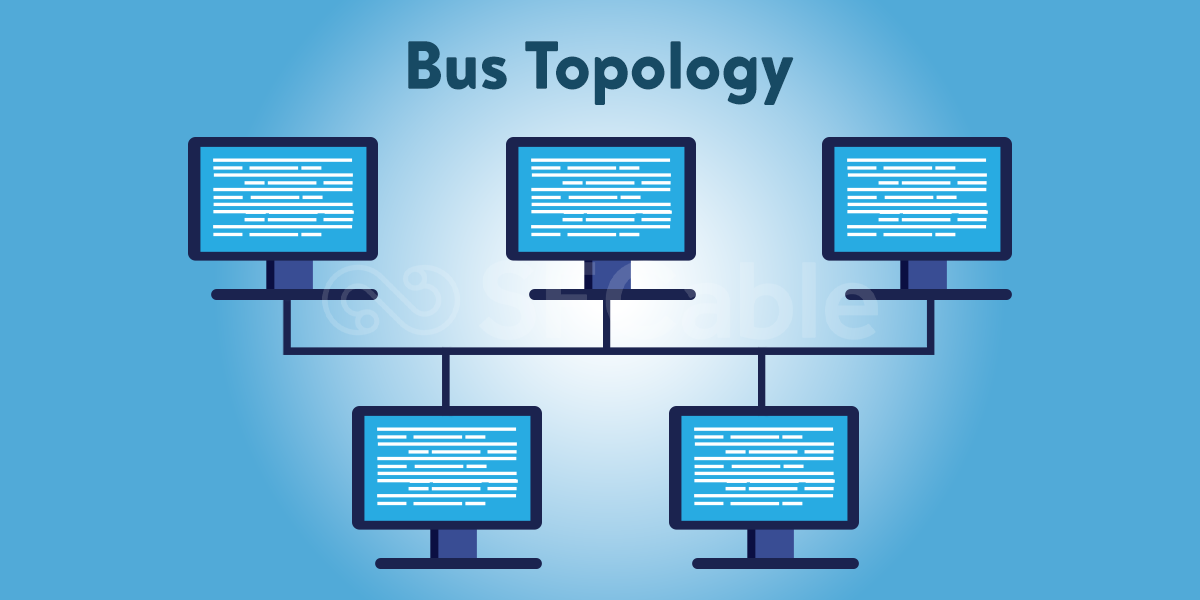
Advantages
- It requires much less cabling than most other topologies.
- Very easy to install for smaller setups.
- Very cost-effective for just basic networking needs.
- Works well within limited devices.
- Straightforward layout for one to understand.
Disadvantages
- The entire network fails if the main cable is faulty.
- Limited maximum length and number of devices it can support, both theoretically and practically.
- A difficult cable fault diagnosis and troubleshooting.
- As more devices are added, the performance is subjected to degradation
- Only one device can communicate at a time.
Use Cases
- Small business LAN setups.
- Temporary laboratory testing networks.
- Classrooms with limited computers.
- Offices that are heavily budget-constrained.
- Simple file sharing systems in home offices.
Star Topology
In a star topology, connections are made from each device to a central hub or switch. The hub handles all information entering or leaving the network. If one device goes down, the rest remain unaffected. However, if the hub fails, everything connected to it is down. This design is more common because it is easier to manage and expand.
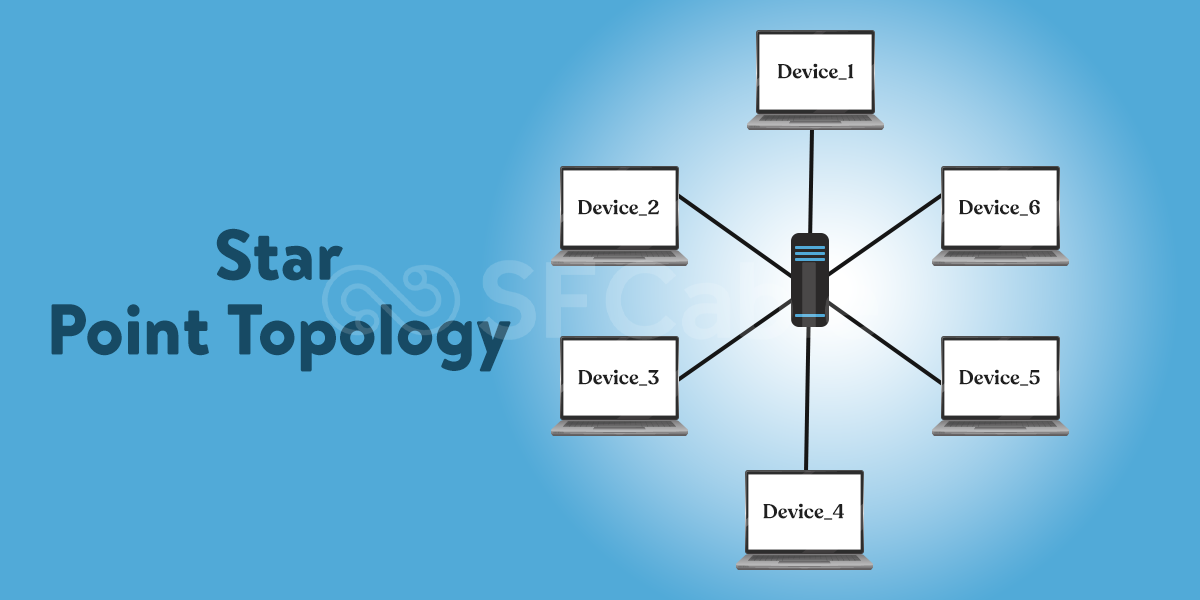
Advantages
- Adding or removing devices can be done easily without affecting the rest
- The failure of one device doesn’t affect the entire network
- Centralised control simplifies monitoring and troubleshooting
- Performance increases over shared cable systems
- Best for wired and wireless setups
Disadvantages
- A central hub or switch failure will take down the whole network
- More cabling is consumed compared to a bus setup
- The cost of the hub or switch adds to the expense
- Can experience high data traffic overload
- Must have uninterrupted power at the hub for uptime
Use Cases
- Office networks with multiple user systems
- Home networks with a centralized Internet connection
- Educational labs with a hub placement
- Data center racks connected through switches
- Gaming setups with multiple PCs connected to a single router
Ring Topology
In ring topology, each device connects to exactly two others, thereby creating a closed loop. Data flows in only one direction, ensuring it traverses all devices until it reaches its destination.
This leads to low data collision, making orderly traffic flow possible. However, if one connection breaks, an entire loop could fail. It is a design that is best suited in situations where the traffic flow is quite predictable.
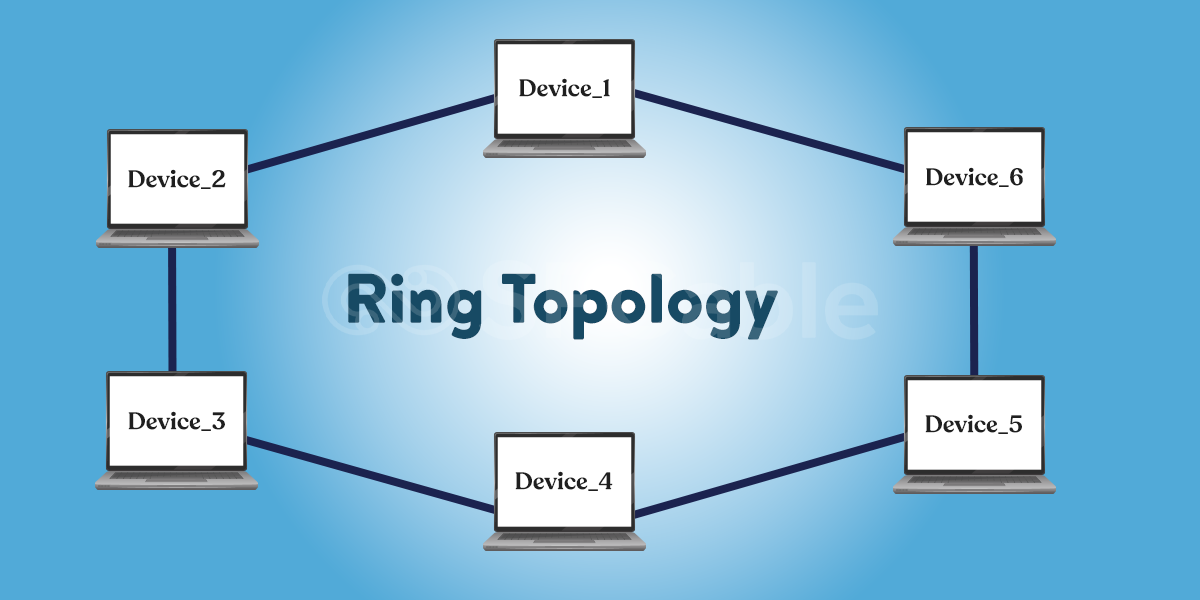
Advantages
- Data travels along a clearly defined, fixed path.
- Minimized collisions in transmissions.
- All devices have equal access to the network.
- Performance remains constant with the addition of devices.
- Very easy to calculate data paths and delays.
Disadvantages
- The whole network is shut down in case of a breakage in the loop.
- Difficult to pinpoint problems.
- Traffic is disrupted by any interruptions/inclusions of devices.
- The performance decreases when the data load is very high.
- Much more cabling is used than in simpler applications.
Use Cases
- Metro fiber ring networks
- Telecom networks cover both voice and data.
- Manufacturing floors with time-critical systems.
- Closed security pathways within governmental entities.
- Legacy campus networks employ token ring systems.
Tree Topology
A tree combination is essentially a combination of the bus topology and the star topology. Small star-shaped groups connect to a central backbone cable. Each group acts independently, but all rely on the main line. If the backbone is strong, the whole structure works well. It is used for networks that are supposed to grow, not initialize from scratch.
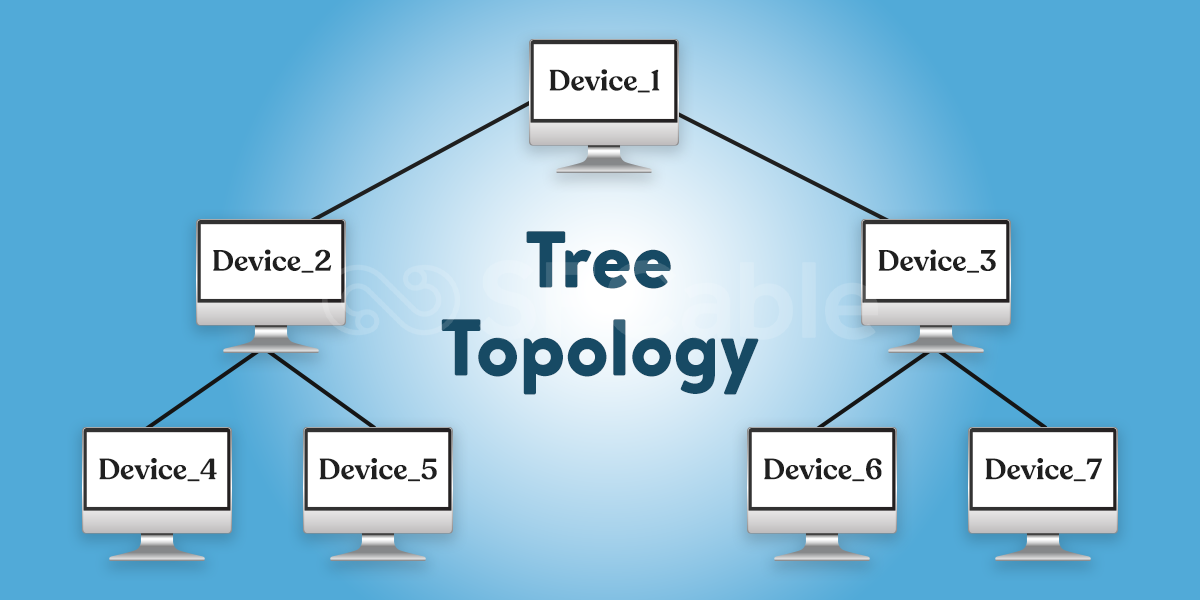
Advantages
- Can be easily expanded to include more branches
- Has a clear, organized structure at several levels
- Troubleshooting can take place at the group level
- Scalability with control
- Can be helpful in dividing a network by function or location
Disadvantages
- Backbone failure will bring the whole network down with it.
- Requires more cable than a simple star or bus network.
- Maintenance is difficult with so many levels.
- Unsuitable for minimal setups.
- Backbone performance can become a bottleneck.
Use Cases
- Networking in universities, across several departments.
- Business campuses with separate buildings.
- Warehousing requiring sectional control.
- Data centre with tiered servers.
- Government networks with a visible hierarchy and divided zones.
Hybrid Topology
A hybrid topology links together two or more distinct network designs. A section could be in a star config, while the other follows mesh or ring. Each section works independently but links to become one larger system. The arrangement allows for freedom of application tailored to a specific requirement. It is commonly used for scenarios where a single topology would not fulfill all requirements.
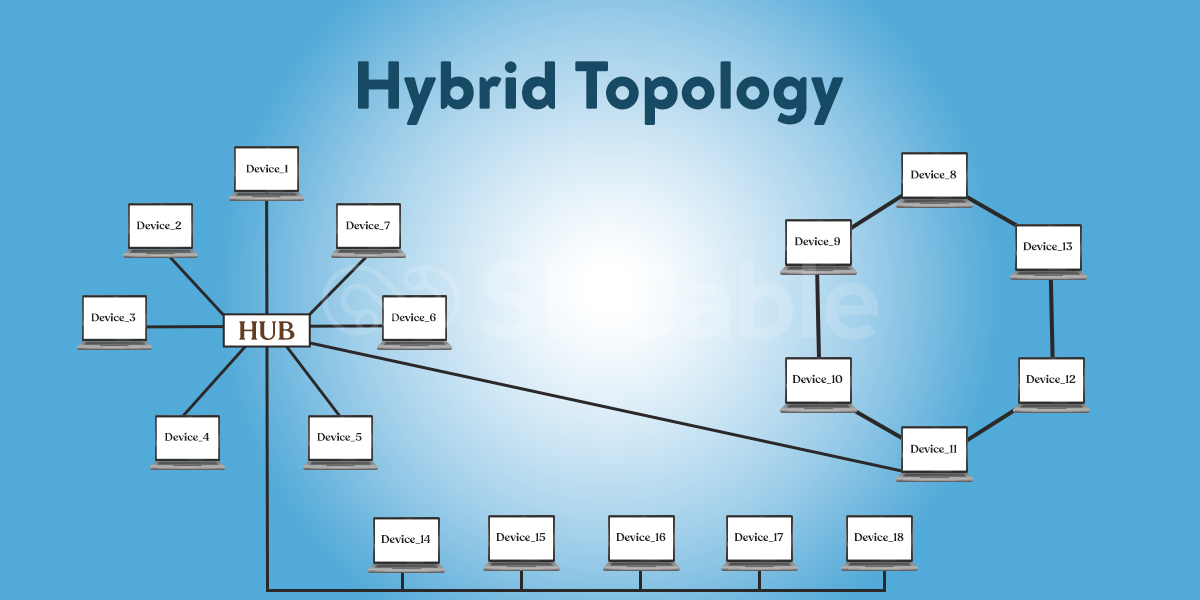
Advantages
- Combines the strengths of various topologies.
- Flexibility across different departments/zones.
- Can scale with the network’s growth.
- Allows custom design according to performance or budget.
- Isolate faults with sections.
Disadvantages
- More complex to design and plan.
- Requires specialized knowledge to troubleshoot.
- Higher cost of installation and maintenance.
- Requires more skilled technical support.
- Compatibility problems might arise between the different segments.
Use Cases
- Corporate networks interface with a mix of workflows.
- ISPs with mixed infrastructure.
- Large hospitals often feature separate zones for various services.
- Universities with different labs, administrative, and student access.
- Smart building requires the interconnection of diverse systems.
Point-to-Point Topology
Point-to-point topology connects just two devices directly. An uninterrupted path is dedicated to data transfer. It is quick, secure, and easy to implement. Typically employed when communication must be directly established and maintained.
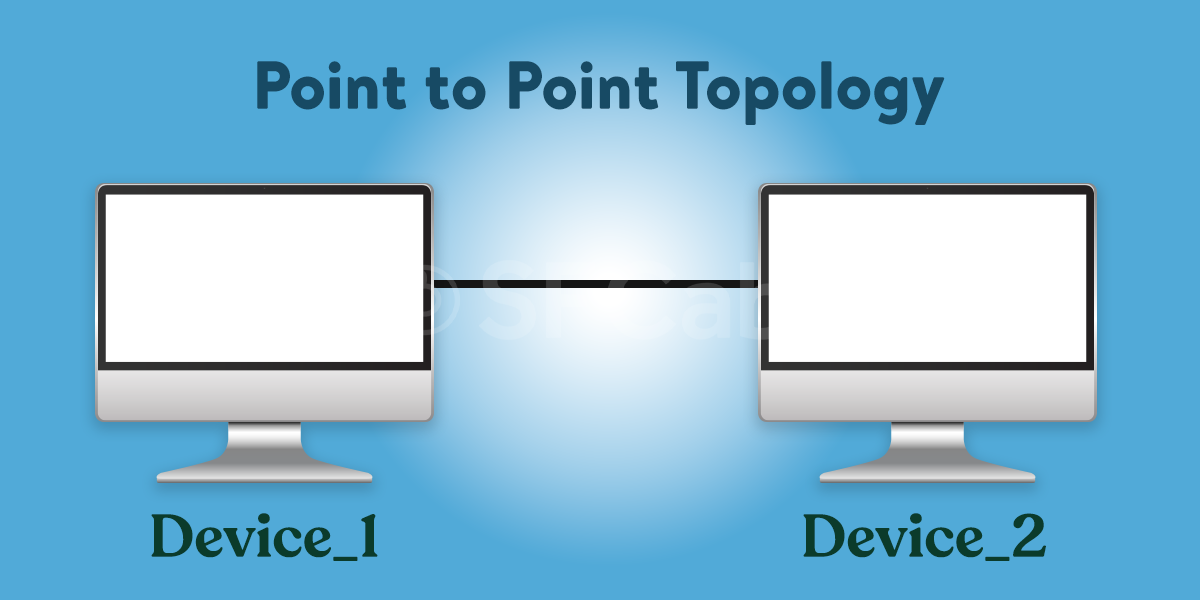
Advantages
- Fast and direct communication
- Easily installed and managed
- Low interference possibility
- Secure connection from endpoint to endpoint
- Minimal configuration
Disadvantages
- Not scalable to more than two devices
- Adding more devices requires additional links
- Breaks on failure
- Not suitable for a large network
- Limited use in a dynamic environment
Use Cases
- Direct connection between two servers
- Printer linked to one computer
- Device-to-device testing environments
- Temporary file sharing between systems
- Secure link for critical systems
Daisy Chain Topology
Daisy chain topology connects each device to exactly two others, thereby creating a linear or loop-like structure. Data travels from one device to another until it reaches its intended destination.
Hence, if any link fails, the entire chain may also be affected. Because this topology is easy to construct, it cannot always be trusted. This arrangement is best suited for short-period or limited-use networks.
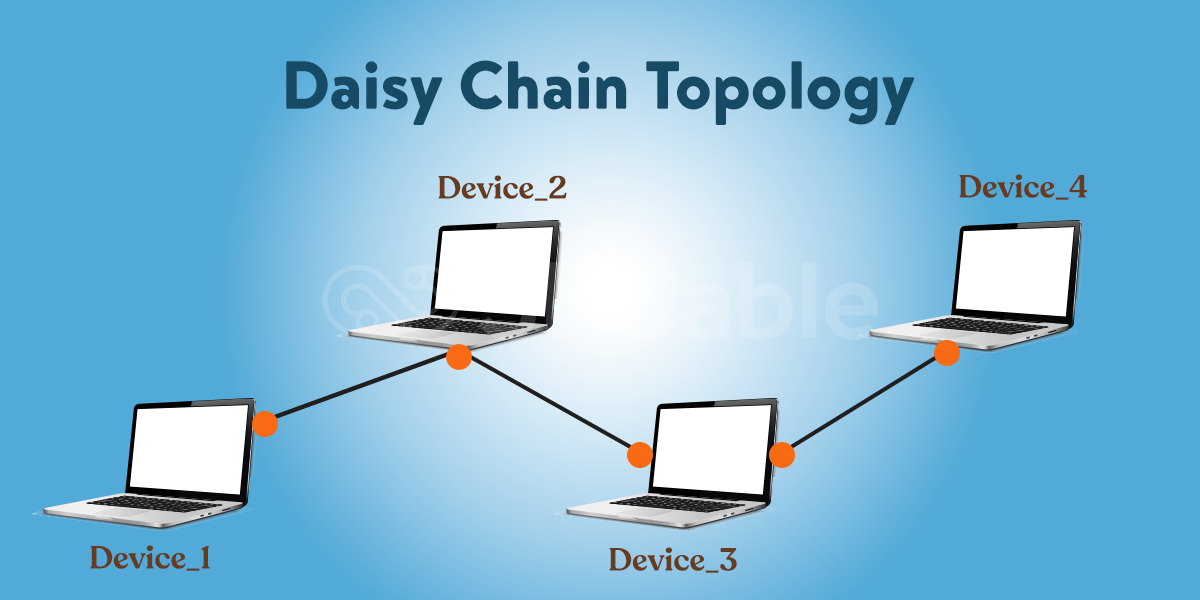
Advantages
- Adding devices to the chain is very easy.
- Requires less cabling than other layouts.
- Cheap in small setups.
- Easy to visualize.
- No central hub is needed.
Disadvantages
- If one point fails, the entire chain could be compromised.
- Tracing down breaks is very difficult in long chains.
- With additional devices, performance drops.
- Can only go so far without signal loss.
- Under load, it can be slow.
Use Cases
- Small office networks.
- Basic lab testing.
- Temporary event setups.
- Classroom computers.
- Older legacy systems with limited expansion needs.
Factors to Consider When Choosing the Right Network Topology
- Size of the Network
The size of the network is primarily determined by the number of devices that are connected to it. A small office with only a few computers could probably get along fine with a pretty simple network topology.
A larger enterprise, however, with hundreds of nodes, requires something far more organized. It should also have provisions for growth destiny without slowing down as the network grows in size. This will prevent the incurring of future expenses on redesigns. - Budget and Cabling Costs
Every networking topology has its own cabling requirements. Mesh, for example, requires many cables, whereas fewer are needed for topologies such as bus and star. However, when one needs to install numerous wires and hardware, costs quickly add up.
One of the key considerations is selecting a layout that aligns perfectly with your budget, as this is an equally important aspect of performance. Cost should be balanced against what the network must support. - Performance and Speed Requirements
Some topologies are better able to accept large amounts of information than others. For instance, mesh can take simultaneous streams of information. Regardless, simpler on the bus can lag under pressure.
Before very long, you will know how much traffic your network will take. A lagging system characterizes poor productivity or games. - Fault Tolerance and Reliability
Not all topologies have the necessary fault recovery abilities. In ring or daisy chain setups, a single broken link can bring down the entire network.
Mesh or hybrids are probably more fault backup paths. Under conditions where network uptime is critical, reliability should be the primary consideration. Now, think of what happens if a cable failure occurs, or even a switch goes offline. - Future Scalability
Networks rarely remain unchanged for extended periods. The addition of new devices, expansion of the team, or new applications are demanding more bandwidth for existing applications.
An expandable layout will save time and money in the long run. Some networking topology choices are more straightforward for attaching additional devices to expand an existing network than others.
Therefore, one would be well advised to think about construction not only in terms of today but even into tomorrow.
Conclusion
Selecting the correct network topology involves more than just cabling and box accounts. It involves knowing how you will handle the future increase, network performance, and failure tolerance.
Each topology, whether bus or mesh, serves a specific type of network. It’s all about matching the design with the requirements, whether you’re talking about a small office, a gaming setup, or a huge data center.
Many familiar network topologies have been designed to facilitate easier planning, minimize downtime, and ensure smooth operation.
A well-planned networking topology saves time, reduces costs, and supports long-term goals. Build it right, and the network will support everything else that is important.
FAQs
- What is the most reliable network topology for large businesses?
The mesh and hybrid topologies are said to be the most reliable in large-scale environments; they present multiple ways for data and significantly reduce the risk of total network failure. - Which network topology is the most cost-effective for small networks?
Bus topology typically emerges as the most cost-effective option for small setups with a few devices, as it requires minimal installation and cabling. - Can different network topologies be combined in a single system?
Yes, hybrid topology allows for having two or more designs to meet a single need. This is beneficial for organizations with different departments that may require varying networks.


